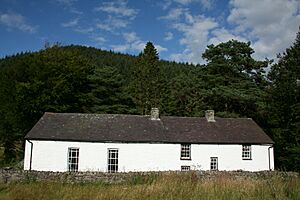Soar y mynydd facts for kids
Quick facts for kids Capel Soar y mynydd |
|
|---|---|
 |
|
| Type | Chapel |
| Location | Ceredigion, Wales |
| Built | 1803 |
|
Listed Building – Grade II*
|
|
| Official name: Capel Soar y mynydd | |
| Designated | 30 September 1997 |
| Reference no. | 18943 |
| Community | Llanddewi Brefi |
| Principal area | Ceredigion |
| Lua error in Module:Location_map at line 420: attempt to index field 'wikibase' (a nil value). | |
Soar-y-mynydd, also known as Soar y mynydd, is a special chapel located in Ceredigion, Wales. It's a Calvinist Methodist chapel, which is a type of Christian church. Many people say it's the most remote chapel in all of Wales, meaning it's very far away from towns and cities. The name "Soar-y-mynydd" means "Zoar of the mountain." Zoar was a safe place mentioned in the Bible.
Contents
Discovering Soar-y-mynydd's Location
Soar-y-mynydd is found in the beautiful Cambrian Mountains. It sits in the valley of the Camddwr river. This area is near the eastern edge of Ceredigion. The chapel is about eight miles southeast of Tregaron. You can find it on the road that leads to Llyn Brianne.
Understanding Calvinistic Methodists
The Calvinistic Methodists are a Welsh Protestant Christian group. They are part of the Presbyterian Church of Wales. Their story began in the late 1730s and 1740s. This was thanks to the preaching of George Whitefield and Howell Harris.
How the Movement Started
These preachers helped start a Christian revival. This was a time when many people became very interested in their faith. The Calvinistic Methodists became a separate group after 1821. Before that, they were connected to the Church of England. They also differed from other Methodist groups.
Beliefs and Language
In 1823, they published their "Confession of Faith." This explained their beliefs, which were a moderate form of Calvinism. The main language used by Calvinistic Methodists has always been Welsh. Services at Soar-y-mynydd are still held in Welsh today.
The History of Soar-y-mynydd Chapel
The chapel was built in 1822. This was right after the Calvinistic Methodists became independent. A key person in building it was Rev. Ebenezer Richard. He was a minister from Tregaron.
Building the Chapel
The land for the chapel was given by John Jones. He was a farmer from Nant-llwyd, a place further down the valley. The chapel was built to serve the sheep farmers in the area. These farmers lived many miles around the chapel.
Saving the Chapel from Closure
By 1968, the number of people attending services had dropped to just two. Soar-y-mynydd was in danger of closing down. However, its future was secured in 1973. Since then, it has been formally reopened.
Modern Day Services and Recognition
Now, special summer services are held there. These services happen on the last Sunday in August. They often have visiting preachers and are well-attended. The chapel has also become famous in the art world. Artist Ogwyn Davies painted it in 1993. It has also been featured in poems by Harri Webb and Iwan Llwyd. The chapel closed for two years during the COVID-19 pandemic. But it happily reopened for services in May 2022.
Architecture and Surroundings
Soar-y-mynydd is a simple building. It is listed as a Grade II* building by Cadw. This means it is a very important historic building. It was built using local stones. These stones were collected from riverbeds and old ruined farmhouses.
Chapel Design
The outside of the chapel is whitewashed. It has a traditional rectangular shape. This part is at the northern end. Attached to it is a small two-story house. This house has two chimneys and a single slate roof. The house is now empty and not used.
Inside the Chapel
You enter the chapel on its longer east side. There are two pairs of doors. The pulpit, where the preacher stands, is between these two doorways. A special feature is a painted scroll above the pulpit. It says "Duw cariad yw," which means 'God is love'. This scroll dates back to 1911.
School and Graveyard
The local school used to meet in the chapel-house. This continued until the 1940s. The chapel area is surrounded by a stone wall. There are also mature trees around it. On the east side of the building, there is a graveyard. The oldest visible gravestone is from 1856. The most noticeable one is from 2001. It belongs to Professor John Griffiths, a famous cancer surgeon.

